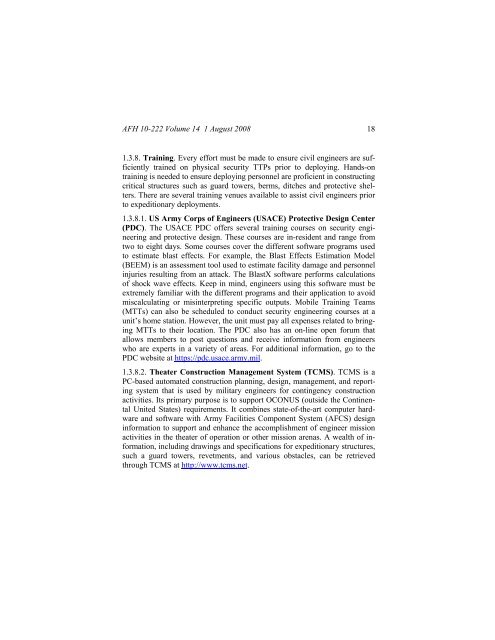Civil engineer guide to fighting positions, shelters, obstacles
Civil engineer guide to fighting positions, shelters, obstacles
Civil engineer guide to fighting positions, shelters, obstacles
Create successful ePaper yourself
Turn your PDF publications into a flip-book with our unique Google optimized e-Paper software.
AFH 10-222 Volume 14 1 August 2008 18<br />
1.3.8. Training. Every effort must be made <strong>to</strong> ensure civil <strong>engineer</strong>s are sufficiently<br />
trained on physical security TTPs prior <strong>to</strong> deploying. Hands-on<br />
training is needed <strong>to</strong> ensure deploying personnel are proficient in constructing<br />
critical structures such as guard <strong>to</strong>wers, berms, ditches and protective <strong>shelters</strong>.<br />
There are several training venues available <strong>to</strong> assist civil <strong>engineer</strong>s prior<br />
<strong>to</strong> expeditionary deployments.<br />
1.3.8.1. US Army Corps of Engineers (USACE) Protective Design Center<br />
(PDC). The USACE PDC offers several training courses on security <strong>engineer</strong>ing<br />
and protective design. These courses are in-resident and range from<br />
two <strong>to</strong> eight days. Some courses cover the different software programs used<br />
<strong>to</strong> estimate blast effects. For example, the Blast Effects Estimation Model<br />
(BEEM) is an assessment <strong>to</strong>ol used <strong>to</strong> estimate facility damage and personnel<br />
injuries resulting from an attack. The BlastX software performs calculations<br />
of shock wave effects. Keep in mind, <strong>engineer</strong>s using this software must be<br />
extremely familiar with the different programs and their application <strong>to</strong> avoid<br />
miscalculating or misinterpreting specific outputs. Mobile Training Teams<br />
(MTTs) can also be scheduled <strong>to</strong> conduct security <strong>engineer</strong>ing courses at a<br />
unit’s home station. However, the unit must pay all expenses related <strong>to</strong> bringing<br />
MTTs <strong>to</strong> their location. The PDC also has an on-line open forum that<br />
allows members <strong>to</strong> post questions and receive information from <strong>engineer</strong>s<br />
who are experts in a variety of areas. For additional information, go <strong>to</strong> the<br />
PDC website at https://pdc.usace.army.mil.<br />
1.3.8.2. Theater Construction Management System (TCMS). TCMS is a<br />
PC-based au<strong>to</strong>mated construction planning, design, management, and reporting<br />
system that is used by military <strong>engineer</strong>s for contingency construction<br />
activities. Its primary purpose is <strong>to</strong> support OCONUS (outside the Continental<br />
United States) requirements. It combines state-of-the-art computer hardware<br />
and software with Army Facilities Component System (AFCS) design<br />
information <strong>to</strong> support and enhance the accomplishment of <strong>engineer</strong> mission<br />
activities in the theater of operation or other mission arenas. A wealth of information,<br />
including drawings and specifications for expeditionary structures,<br />
such a guard <strong>to</strong>wers, revetments, and various <strong>obstacles</strong>, can be retrieved<br />
through TCMS at http://www.tcms.net.
















